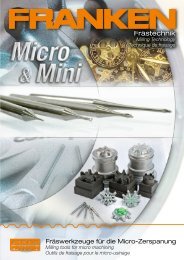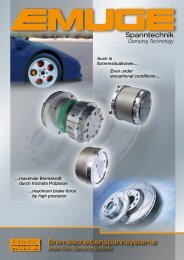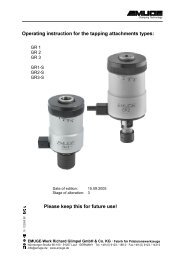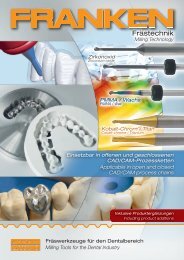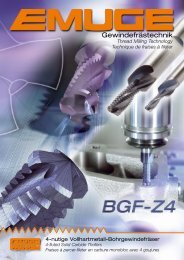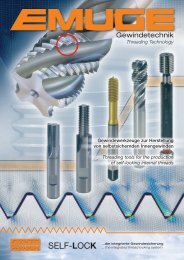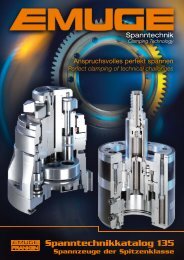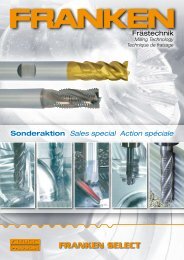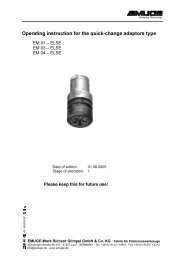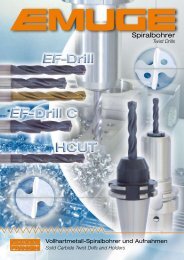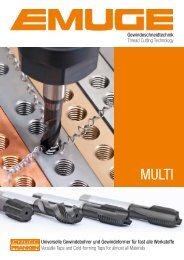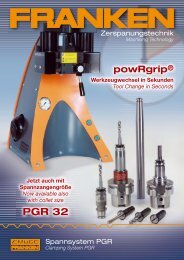Gewindetechnik - Emuge UK
Gewindetechnik - Emuge UK
Gewindetechnik - Emuge UK
Sie wollen auch ein ePaper? Erhöhen Sie die Reichweite Ihrer Titel.
YUMPU macht aus Druck-PDFs automatisch weboptimierte ePaper, die Google liebt.
<strong>Gewindetechnik</strong>Threading TechnologyDurchlaufverfahren mit steigungslosen RillenrollenThroughfeed process with pitchless grooved rolls1 2 3BeschreibungDescriptionVorteileAdvantagesKennzeichenCharacteristics• Walzwerkzeuge weisen am Umfang steigungslose Rillen auf• Walzwerkzeuge müssen um die horizontale Querachse um den Werkstücksteigungswinkelgeschwenkt werden• Walzwerkzeug besteht aus drei Umformbereichen:Einlaufkegel (1), Kalibrierbereich (2) und Auslaufkegel (3)• Einlaufkegel (1) formt kontinuierlich das Material bis zur vollen Profilhöhe auf• Kalibrierbereich (2) führt und egalisiert das fertig aufgeformte Profilauf 8-10 Gängen• Auslaufkegel (3) dient zur übergangslosen Entlastung der fertigenGewindespindel• Werkstückrohling walzt sich durch das Walzenpaar hindurch• Walzen rotieren synchron mit gleichem Drehsinn• Walzen werden radial zusammengeführt und üben somit Reibdruck aufdas Werkstück aus, axialer Transport der Gewindespindel erfolgt ab demBerührungszeitpunkt• Axialer Transport beträgt bei einer Werkstückumdrehung einmal die Steigung• Einsatz beim Walzen langer Gewindestangen• Wirtschaftliches Verfahren• Mit einem Rollenpaar kann Rechts- und Linksgewinde erzeugt werden• Mit einem Rollenpaar können unterschiedliche Werkstückdurchmessererzeugt werden• Werkstück rotiert und bewegt sich axial mit großem Vorschub vorwärts• Rollenbreite ist von der zu erzeugenden Steigung abhängig und wirdkonstruktiv ermittelt• Die Walzmaschinenachsen müssen entsprechend dem Steigungswinkel desWerkstücks schwenkbar sein• The rolling tools are provided with pitchless grooves on the circumference• The rolling tools must be slewed into the pitch angle to be produced on theworkpiece• The rolling tool consists of three different roll-forming areas:run-in taper (1), calibrating area (2) and run-out taper (3)• The run-in taper (1) cold-forms the workpiece material to its full profile heightcontinuously• The calibrating area (2) guides and egalizes the finished formed profile overa length of 8-10 threads• The run-out taper provides a seamless stress release on the finished threadspindle• The workpiece blank rolls its way through the pair of thread rolls• The rolls rotate in synchronous movement with the same sense of rotation• The rolls close in a radial movement, exerting friction pressure on theworkpiece, and providing axial transport of the thread spindle from themoment of first contact• The axial transport amounts to one times the pitch during one workpiecerevolution• To be used for the rolling of long threaded bars• Economically efficient production process• With just one pair of rolls, both right-hand and left-hand threads can beproduced• With just one pair of rolls, different workpiece diameters can be produced• The workpiece rotates and moves forward axially with a high feed rate• The width of the rolls depends on the pitch to be produced, and is determinedin construction• The axes of the rolling machine must be slewable in accordance with thepitch angle of the workpiece6



